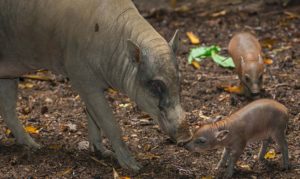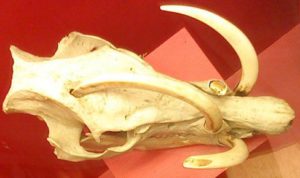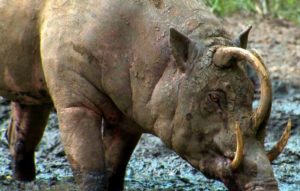What is a Babirusa?
The babirusa (Babyrousa babyrussa) is a bizarre-looking pig from Indonesia. The males have extraordinary tusks which develop from their canine teeth, growing up through the skull and growing in a curve until it pierces the skull again between the eyes. The babirusa has been called “a wild pig with a dental problem.”
What Does Babirus Mean?
The word babirusa means “pig deer” in Malagasy, as their wild-growing tusks are reminiscent of deer antlers.
How Long do Babirusa Live?
Up to 24 years in captivity. In the wild an old babirus is 10 years old.
How Many Species of Babirusa Are There?
There are four species of babirusa. The most well-known (Babyrousa celebensis — the naked-looking babirusa with the monster tusks) is found on Sulawesi. The other species of babirusa have longer coats that vary in color from white to creamy gold to black and brown.
What does a Babirusa Look Like?
The babirusa is a bizarre-looking pig with males having curved tusks growing vertically up through its upper jaw and curving back down to pierce the skull between the eyes. The lower canine teeth also grow upwards and curve back to form a second set of tusks. The skin is a brownish grey colour and is covered in sparse white or grey bristles.
Babirusa can vary by species in other characteristics. The golden babirusa has a long, thick pelage that is white, creamy gold, black or gold overall and black at the rump. The pelage of the Togian babirusa is also long but not as that of the golden babirusa. The Togian babirusa has a tawny, brown or black pelage that is darker on the upper parts than in the lower parts. The North Sulawesi babirusa has very short hair and appears bald.
How Big is a Babirusa?
Babirusa can reach 3 to 3.7 feet in length and weigh up to 220 pounds. Tail is usually 10.5 to 12.5 inches long. Males are larger than females.
What are Babirusa Tusks For?
It’s actually a mystery. One hypothesis is that the males use their tusks during fights over  females. It seems reasonable, until you look at how babirusas really fight. They don’t hook tusks, but stand up on their hind legs and “box” each other with their front hooves. Additionally, babirusa tusks aren’t built to withstand much pressure; they are brittle and easily broken, not at all suited for combat. It seems likely that the tusks serve a display purpose, perhaps signaling genetic fitness to females, but this is an idea that hasn’t been tested. For now, the purpose of those marvelous tusks is still a mystery.
females. It seems reasonable, until you look at how babirusas really fight. They don’t hook tusks, but stand up on their hind legs and “box” each other with their front hooves. Additionally, babirusa tusks aren’t built to withstand much pressure; they are brittle and easily broken, not at all suited for combat. It seems likely that the tusks serve a display purpose, perhaps signaling genetic fitness to females, but this is an idea that hasn’t been tested. For now, the purpose of those marvelous tusks is still a mystery.
What Is the Babirusa Tusk Death?
Babirusas with spiralling tusks, some authors say that, if the animal lives long enough, the tusks grow fatally into the face.
Where are Babirusa Found?
The babirusa is only found on a few Indonesian islands: Sulawesi, Togian, Sulu and Burn Islands.
Babirusa Habitat
In the wild, male babirusas tend to live in solitary or in bachelor herds of two to three males, while females can be found in groups of up to eight individuals with young. They spend the majority of the day roaming and foraging throughout the forest.
What do Babirusa Eat?
Babirusas are omnivorous, eating mainly fruit but also leaves, grasses, small animals and carrion.
Babirusa Behaviour
Babirusa live in groups of one or a few adult females and their young while the adult males are solitary. They spend much of the day in mud wallows, rubbing off the dried mud and skin parasites on trees afterwards.
Babirusa Reproduction
The males stand on their hind legs and ‘box’, presumably trying to break their opponent’s tusks. 125-150 days after mating the females produce a very small litter of only 1-2 piglets, born in a nest of underbrush. She has only one pair of teats from which to feed them.
Babirusa Conservation status
The babirusa is listed as Vulnerable, following increased hunting and habitat loss over the last 20 years or more. Despite protection, illegal poaching continues and only a few thousand individuals are left.
Sources: